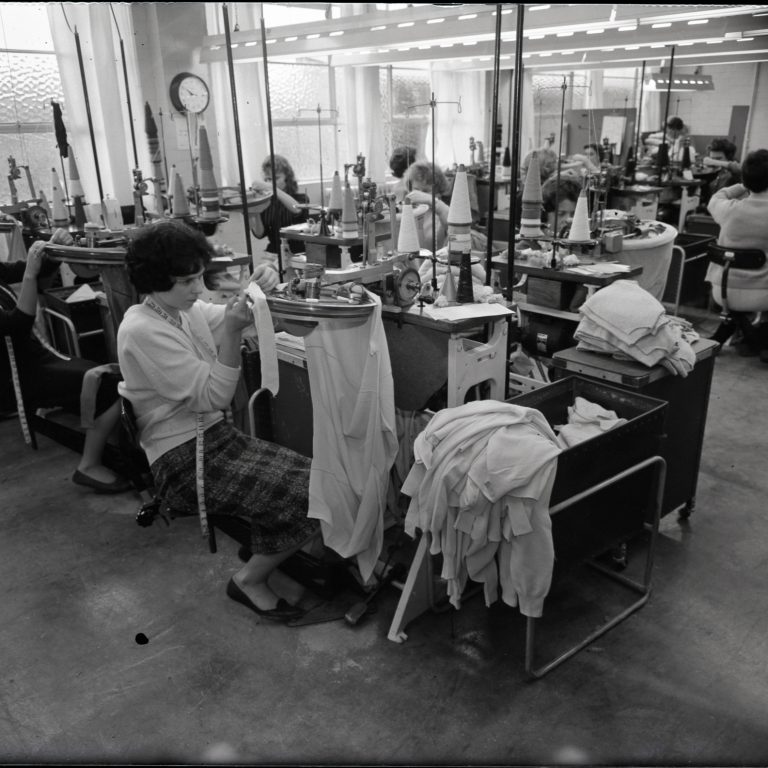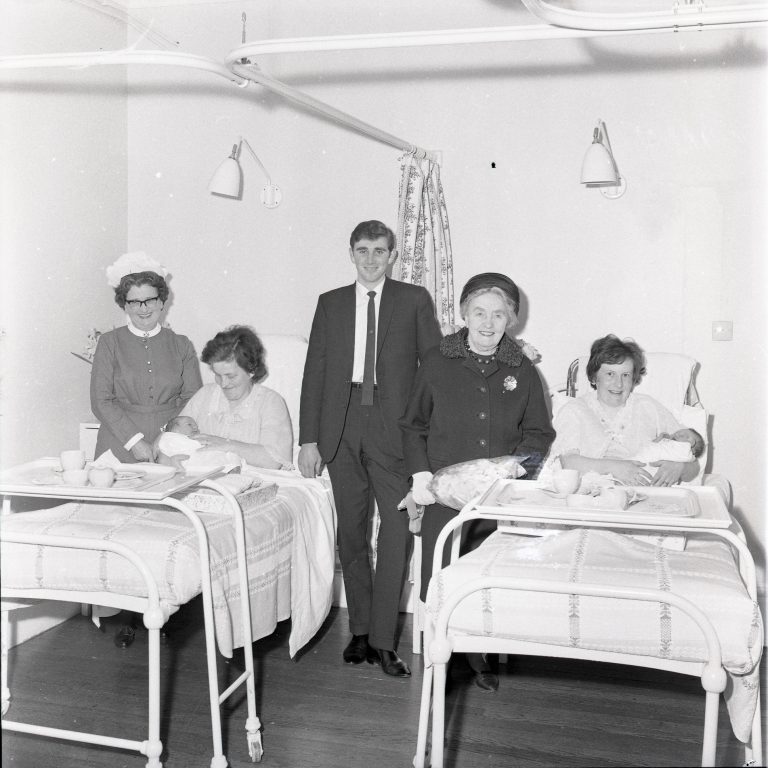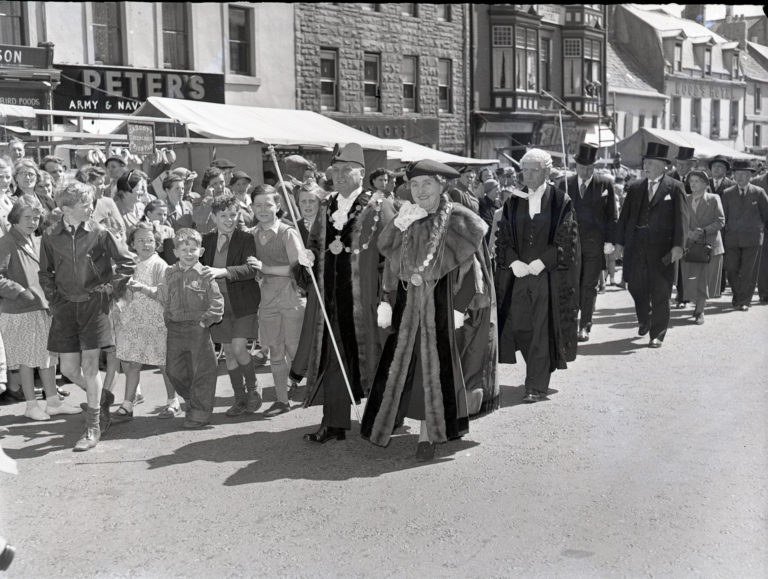Photographs of Women in Berwick, 1954 – 1968
Reference: BRO 1944/1/3014/13, BRO 1944/1/4529/19 BRO 1944/1/1229/2,
BRO 1944/1/270/1
Suggested age groups: KS2, KS3, KS4, KS5, Lifelong Learners
Topic areas: Photography, Photojournalism, Women’s History, Healthcare
CONTEXT
Originally founded in 1951 as the Photo-News Service, the Photo Centre in Berwick was a staple of town life for over 65 years as a family-run press agency and photo studio.
Their premises at 17 Bridge Street had a well-equipped studio above the shop where commercial photography took place. The business also covered newsworthy events in the area and recorded family occasions and celebrations, marking milestones in the lives of several generations of townspeople.
In February 1948 the well-known knitwear firm Pringle of Scotland set up a branch factory in Berwick-upon-Tweed in Walkergate. Initially it employed only 4 women to finish garments, but the business expanded, eventually moved to the Tweedmouth Industrial Estate, employing many local women in skilled labour. The first photograph (BRO 1944/1/3014/13) shows staff working on collar binding in October 1960. The factory closed in 1998 resulting in the loss of many jobs for its predominantly female workforce.
The second photograph (BRO 1944/1/4529/19) shows Castlehills Maternity Home celebrating its 21st birthday on 6th April 1966. Opened in April 1945, this was a much-needed facility before the introduction of the NHS. Originally equipped with 10, and later 16, beds local babies were born here until 1986 when it was replaced with the present maternity unit attached to Berwick Infirmary.
The third photograph (BRO 1944/1/1229/2) shows The Mayor, Alderman Mrs B.F.C. Adams and the Sheriff William Elder on 25th May 1956. Here they are continuing the centuries old tradition of officially opening Berwick May Fair by “walking the fair”. They processed up Marygate past all the stalls accompanied by the Civic Party of councillors and town officials. This tradition continues today but on a smaller scale.
The final photograph (BRO 1944/1/670/1) shows the crowning of the Salmon Queen on 22nd July 1954. This traditionally took place in mid-July as part of the celebrations for the Tweedmouth Feast during the Berwick Trades Fortnight’s Holiday. The photograph shows Salmon Queen Maude Gray with her attendants Daphne Martin and Marie Peacock, and trainbearers Betty Price and Pamela Rosie. The Salmon Queen was chosen at a dance. This tradition continues today.
Mrs Betty Fithie Calder Adams was born in Dundee in 1888. After attending Glasgow University and becoming a schoolteacher, she moved to Berwick with her husband and their 3 children in 1923. Mrs Adams was interested in politics and local people, unsuccessfully standing for election as a Labour Candidate for Berwick Town Council in 1925. Instead, she threw her energies into helping women and promoting their welfare – she was a founder member of the Tweedside Co-operative’s Women’s Guild, established in the late 1920s and was one of the main fundraisers for the Castlehills Maternity Home in Berwick.
In 1937 Mrs Adams became a Labour Town Councillor for Tweedmouth, continuing to be elected right up until 1967. Her husband, James who was already a Councillor by then served as Berwick’s Mayor twice during the Second World War. Mrs Adams became a Northumberland County Councillor in 1946 with a particular interest in education and family welfare.
In 1954 Mrs Adams was elected Mayor of Berwick – the first woman to hold this post since it was started in the medieval period. She was obviously well respected and did a good job as she was re-elected in 1955 and 1956. The culmination of her time as Mayor was the Queen’s Visit to Berwick on 7 July 1956. Mrs Adams services to the community were recognised in 1958 when she was awarded the OBE – “for untiring public service over more than 30 years“.
In January 1970, Berwick Town Council bestowed its highest honour on Mrs Adams – the Honorary Freedom of the Town. She was the first woman to be given this honour. Mrs Adams died in September 1982, aged nearly 94. She was a woman who devoted her life to supporting others in the community.
In the early 1930s following the death of a woman in childbirth, many people wanted better maternity provision in Berwick and a Maternity Home for the area. On 3 October 1933 a Public Meeting was held in the town, led by Mrs Betty Adams. Over 400 women attended, and it was agreed to push Northumberland County Council to provide a child welfare and maternity hospital at Berwick.
In addition, a committee was formed under the direction of Mrs Adams to raise funds to support the hospital. The committee held bazaars and in 1934 inaugurated a Carnival/ Pageant in Tweedmouth Feast Week. In August 1938 a Garden Fete was held at Ladykirk – attended by over 750 people. The Second World War slowed down the fundraising efforts. However, in 1942, Northumberland County Council agreed to lease Castlehiils, a large country house on the outskirts of Berwick, overlooking the River Tweed and convert it into a Maternity Home. The money raised by the local ladies was used to furnish it and make it more comfortable for mothers and babies.
It was eventually opened on 26 April 1945 and in 1949 celebrated the birth of its 1000th baby. Castlehills continued as a Maternity home until 1986 when a new Maternity Unit was built beside Berwick Infirmary in the centre of town.
Tweedmouth Feast was first established in the medieval period and still takes place today, during the month of July. It celebrates the area’s close association with salmon and the River Tweed. By the beginning of the 20th century, the Feast was less popular and so after the Second World War it was revived with the additional of a new element – the crowning of a Salmon Queen who was accompanied by her attendants.
In 1947 Miss Dorothy Coulthard was appointed as the first Salmon Queen. Initially the Queen and her attendants were chosen at a Dance but by 1965, this had changed. Since then, the Salmon Queen and her attendants are chosen from local schools in Tweedmouth. The Queen is usually crowned at a ceremony in mid July which marks the opening of Tweedmouth Feast.
Photojournalism is a type of journalism that uses images to tell a news story. Photojournalism usually refers to photographs, but sometimes the term can be used to describe videos used in broadcast journalism.
Photo essays are a form of visual storytelling, presenting a narrative through a series of images. Photo essays can be powerful ways to evoke emotion and understanding without using words.
ARTISTS BANK
Kitra Cahana
Kitra Cahana is a documentary photographer, photojournalist, and photo/video artist. She is a contributing photographer for National Geographic Magazine and a TED speaker. She has produced a number of photo-essays and documentary videos on various different subjects both for National Geographic and as a freelance photographer. She has won awards for investigative journalism.
Portfolio: https://kitracahana.com/
Stephanie Sinclair
Stephanie Sinclair is known for producing photographic essays about the most sensitive gender and human rights issues around the world. She has documented the defining conflicts of the last decade, and covered the everyday brutality faced by young girls in developing countries around the world.
Portfolio: https://stephaniesinclair.com/
Steve McCurry
Steve McCurry is an American photojournalist. He has covered many armed conflicts particularly in the Middle East and Asia. Many of his photographs concentrate on the toll war takes on humans. His most famous photograph is Afghan Girl (1984), depicting a young girl named Sharbat Gula at the Nasir Bagh refugee camp on the border of Afghanistan and Pakistan.
Portfolio: https://stevemccurry.com/
Rena Effendi
Rena Effendi is a social documentary photographer. Her works tend to focus on stories that are either well-known or underrated, her early work focused on the oil industry and how it effects people’s lives. She also has photographic series responding to wildlife conservation and environmental decay.
Portfolio: http://www.refendi.com/
Lynsey Addario
Lynsey Addario is an American photojournalist. Her work often focuses on conflict, human rights issues, and the role of women in traditional societies. In the early 2000s she traveled to Afghanistan under Taliban rule to document life and oppression under the Taliban.
Portfolio: http://www.lynseyaddario.com/
ACTIVITIES
ACTIVITY 1
Background
In 1954 Mrs Adams was elected Mayor of Berwick – the first woman to hold this post since it was started in the medieval period. She was obviously well respected and did a good job as she was re-elected in 1955 and 1956.
On 3 October 1933 a Public Meeting was held in the town, led by Mrs Betty Adams. Over 400 women attended, and it was agreed to push Northumberland County Council to provide a child welfare and maternity hospital at Berwick.
In 1942, Northumberland County Council agreed to lease Castlehiils, a large country house on the outskirts of Berwick, overlooking the River Tweed and convert it into a Maternity Home. The money raised by the local ladies was used to furnish it and make it more comfortable for mothers and babies.
SEE
See: What is shown in each of these photographs?
See: What was Mrs Adams’ role in Berwick?
See: Why did Mrs Adams and other women campaign for the opening of Castlehills Maternity Home?
See: When was the Tweedmouth Feast established?
See: What does the Tweedmouth Feast celebrate?
THINK
Think: Are there any annual traditions in your local area?
Think: Why are local traditions important?
Think: How have jobs for women changed over the last 100 years?
Think: What types of issues did women face in the workplace during the early, mid, and late 20th century?
Think: What types of issues do women face in the workplace today?
Think: How has maternity care changed over time?
DO
Do: Write a newspaper article to accompany one of the four images. Use the contextual information and any additional research to help you.
Do: Find evidence of women campaigning for change throughout history. Create a timeline showing these campaigns and annotate the changes that were made as a result of them.
Do: Compare maternity care today to maternity care during the mid-20th century. Debate the cause of the changes. Are they a result of social changes, political pressure, medical advancements?
Do: Discuss whether there a gender inequality in healthcare today.
Do: Create a poster showing the changing roles of women in Britain throughout the 20th century. Can you find the causes of these changes?
Do: Identify a prominent female figure in your local community from the past. Create a biography celebrating her and telling her story.
Do: Identify a prominent female figure in your local community today. Create a photo essay to tell her story.
Do: Take photographs of local women at work. Write an article about the local female workforce to accompany your photographs.
Do: Plan an event to celebrate local women and girls. Think about how this could become an annual local tradition.
Do: Design a poster for your event.
Do: Create a campaign poster for Mrs Adams to use during her mayoral election campaign.
Do: Imagine you are Mrs Adams. Write a speech she may have given at the Public Meeting on 3rd October 1933. You might want to investigate information and statistics about maternity care and mortality around this time.
Do: Imagine you are Mrs Adams. Write a speech she may have given at the opening of Castlehills Maternity Home.
Resources
ACTIVITY 2
Background
Photo essays are a form of visual storytelling, presenting a narrative through a series of images. Photo essays can be powerful ways to evoke emotion and understanding without using words.
SEE
See: What is photojournalism?
See: What are the main characteristics of a photojournalism image?
See: What are the aims of a photojournalism image?
See: What is a photo essay?
See: What can a photo essay evoke?
THINK
Think: How can photo essays be used to give a sense of place?
Think: How can photo essays be used to understand different cultures?
Think: How can photography change the way that we see and perceive things?
Think: How can we use photographs to learn about places?
Think: How can we use photographs to learn about people?
Think: Can an outsider take photographs that capture the culture and lives of a place that is new to them?
DO
Do: Look at examples of photojournalist or documentary photographer who has produced photo essays based around place, community, and culture.
Do: Analyse the photo essays you have been looking at. What makes these images powerful or successful? What tools have the photographers used to convey their message?
Do: Think about your local area, culture, and community. What is significant about it, what makes it important to you, and what would you want other people to know about it?
Do: Choose one aspect of your local area, culture or community that is important to you. Think about how you could convey its significance to someone else. Plan a photo essay around this theme.
Do: Create your photo essay.
Do: Think about how you would present your photographic essay in a way that would have the most impact. Would it be in a magazine, a traditional exhibition, a pop-up exhibit in a community, or something else? Plan how you would do this.
Do: Present your photo essay in your chosen format.
Do: Evaluate your photo essay. Did you achieve your intentions? What was successful and why? What could be improved in the future?
Do: Look at different examples of photo essays and the way that different artistic styles can change the message of the essay.
Do: Experiment with how different artistic styles can change the meaning of the same image. You could try photographing the same scene in different ways, experiment with lighting or effects, or experiment with editing the same image in different ways.
Do: Choose your own topic that you would like to create a photographic essay about. Plan your photo essay and use your own artistic style to portray your intentions of the essay.
Do: Consider whether you would like your photo essay to be mixed media or purely photographic – could you work into the photographs using 3D elements, add motion or sound, create a sculpture or installation with your work?
Do: Present your photo essay in your chosen way.
Do: Evaluate your photo essay. Did you achieve your intentions? What was successful and why? What could be improved in the future?
Resources
OTHER ONLINE RESOURCES
Early Photography
Science Museum website, page about history of photography: https://www.scienceandmediamuseum.org.uk/objects-and-stories/history-photography
British Library website, page about invention of photograph (Henry Fox Talbot): https://www.bl.uk/collection-items/invention-of-photography
Bodleian website, biography of Henry Fox Talbot: https://talbot.bodleian.ox.ac.uk/talbot/biography/
Photo Centre
Portrait of a Town exhibition: https://www.photocentreberwick.co.uk/portrait-of-a-town/work-and-industry
Photo Centre workshop resources: https://www.photocentreberwick.co.uk/learning
Photojournalism
Tate page about photojournalism: https://www.tate.org.uk/art/art-terms/p/photojournalism
V&A page about photojournalism: http://www.vam.ac.uk/content/articles/p/photojournalism/
National Geographic page about the best photojournalism stories of the last decade: https://www.nationalgeographic.co.uk/photography/2020/10/the-best-photojournalism-of-the-last-decade
Page for the National Press Photographers Association: https://nppa.org/





